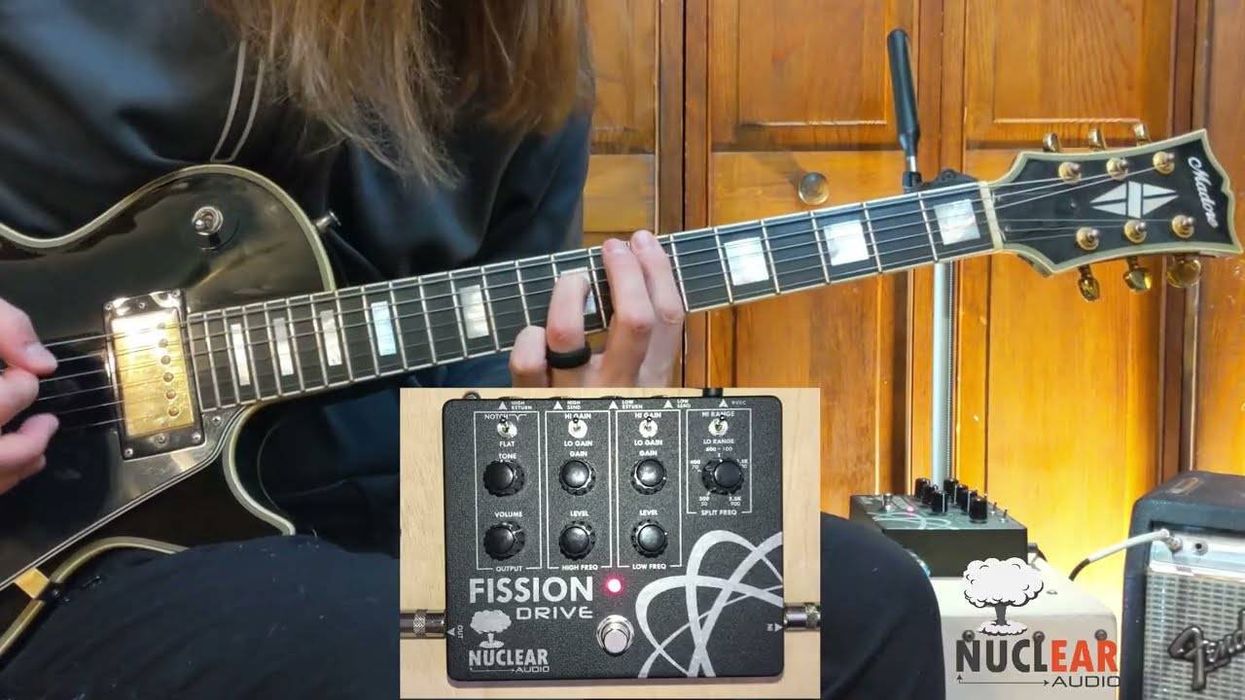Yamaha has a reputation for delivering quality instruments at reasonable prices, and their new budget-priced 5-string bass is a perfect example. The TRBX505 is a solidly crafted, Indonesian-made axe offering excellent tone and feel for a street price of $549.
Black Beauty
Our translucent-black test instrument displays strong attention to detail. The burnished pewter finish of the die-cast hardware pairs well with the no-nonsense finish. Combining a lightweight, ergonomically sculpted body with a rather chunky 5-piece maple/mahogany bolt-on neck, the 505 felt a bit neck-heavy on my lap, though it balances well on a strap. It was always comfortable for my right arm, however—all that contouring means no abrasive edges.
The neck has a substantial, medium-depth C-profile and a satiny oil finish with beautiful contrasting stripes. The neck required a truss-rod adjustment after its overseas journey, but the included hex wrench made quick work of it—the neck responded quickly and precisely.
The electronics are impressive for a bass at this price point. The control cavity is clean and well shielded, and the battery gets its own compartment. (Kudos to Yamaha for including an LED to indicate the current charge.) The alnico-5 humbuckers have the look of pricy boutique pickups, and each unit has four pole pieces bracketing each string to maximize response to off-axis vibration.
The preamp is clever too. At first glance it resembles the active 3-band EQ designs seen on many basses, but it houses a hidden feature: When the 2-way switch is in passive mode, the treble control acts as a master tone control, rolling off highs. This way, the TRBX505’s active and passive modes are capable of genuinely different flavors, unlike on many active basses, where passive mode feels like a mere dead-battery workaround.
Bottom-End Bargain
I immediately took to the TRBX505’s utilitarian look and feel and its clear, consistent tones. (I tested it through a Warwick LWA 1000 paired with an Epifani UL D.I.S.T. 112 and a Crest Audio CA9 with an Epifani UL D.I.S.T. 410.) Like other Yamaha basses I’ve encountered, its voice is clear and open.
Ratings
Pros:
Excellent construction for the price. Clever electronics. Slamming 5th string.
Cons:
Neck tends to dive when played sitting down.
Tones:
Playability:
Build/Design:
Value:
Street:
$549
Yamaha TRBX505
usa.yamaha.com
Soloing the bridge pickup in active mode yields the sort of “burpy” tone Jaco-heads love for uptempo fingerstyle, though I found the tone benefited from a dose of the EQ’s bass filter. The soloed neck tone is woody, with vintage-style thud and aggressive upper mids. Passive mode, with its accompanying tone control, provides an entirely distinct palette. Rolling back the tone control produces a deeper, darker sound than cutting treble with the preamp engaged, much like old-school Fenders. It’s nice to see a modern bass that can sizzle like a skillet of bacon while offering such a range of more traditional tones. The gain barely changes when switching to passive, which is great for real-world use.
In active mode, the slap tone is aggressive, with a subtle midrange hollowness that lends itself to cutting, propulsive styles. Digging in with a pick also proved sonically lucrative. The instrument’s taut, articulate tones are an excellent platform for aggressive effects.
The 5th string sound remarkably deep and authoritative, with strong pitch definition. The string feels less floppy and sounds more focused than ones I’ve encountered on basses costing five times as much.
The Verdict
The TRBX505 is a comfortable and solidly constructed bass with tone and features that belie its $550 price tag. I especially dug the impressively tight 5th string. A clever passive mode adds a new range of sounds to the 505’s already inspiring active tones. If you’re on the hunt for a versatile new workhorse that won’t set you back much coin, the TRBX505 definitely merits an audition.







![Rig Rundown: AFI [2025]](https://www.premierguitar.com/media-library/youtube.jpg?id=62064741&width=1245&height=700&quality=70&coordinates=0%2C0%2C0%2C0)












 Shop Scott's Rig
Shop Scott's Rig


![Rig Rundown: Russian Circles’ Mike Sullivan [2025]](https://www.premierguitar.com/media-library/youtube.jpg?id=62303631&width=1245&height=700&quality=70&coordinates=0%2C0%2C0%2C0)












































